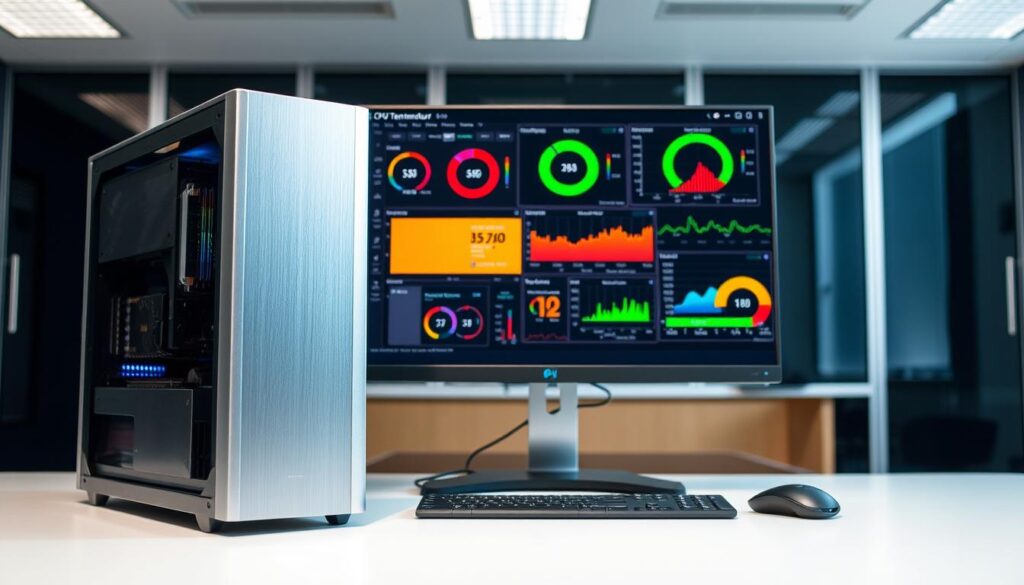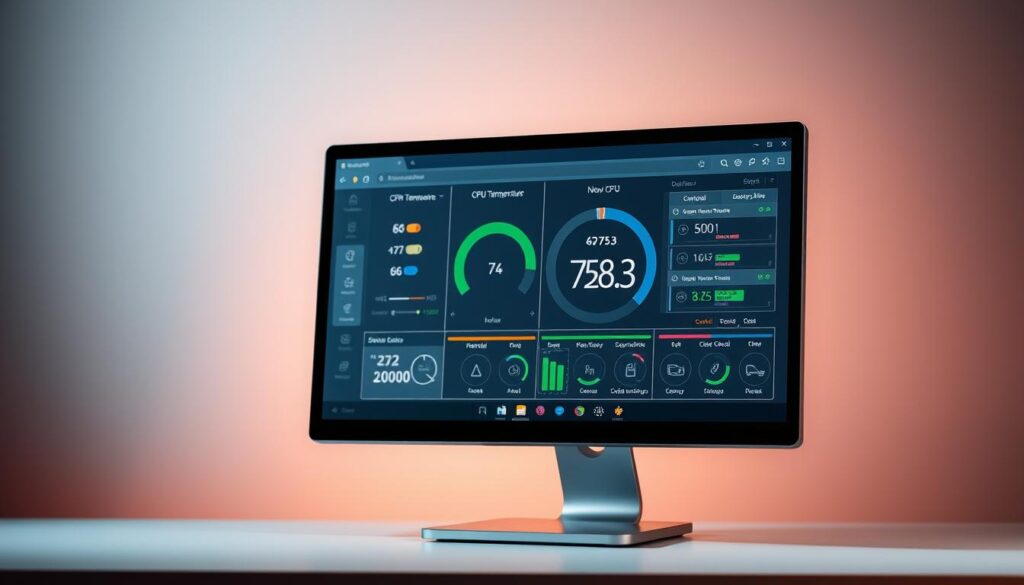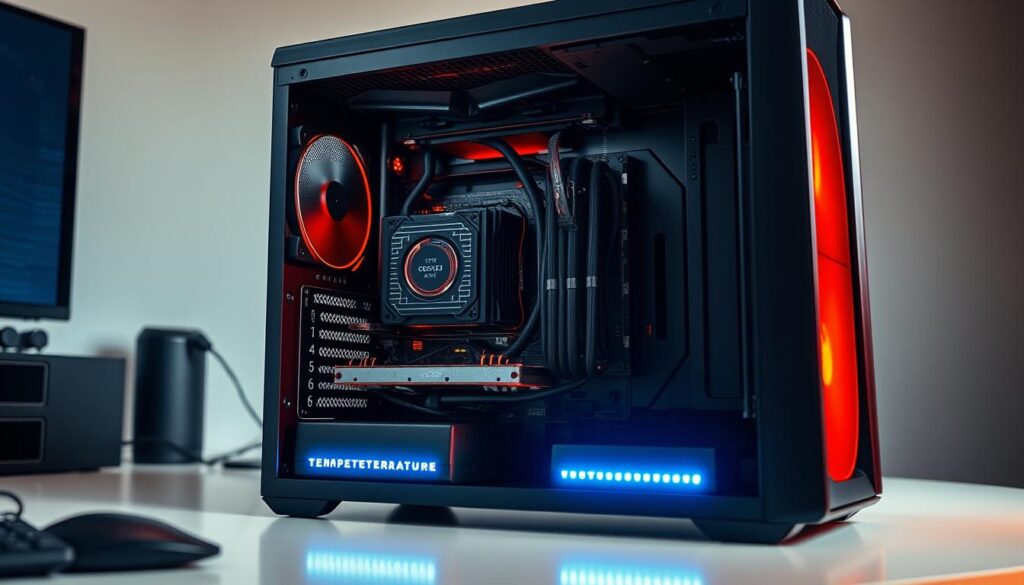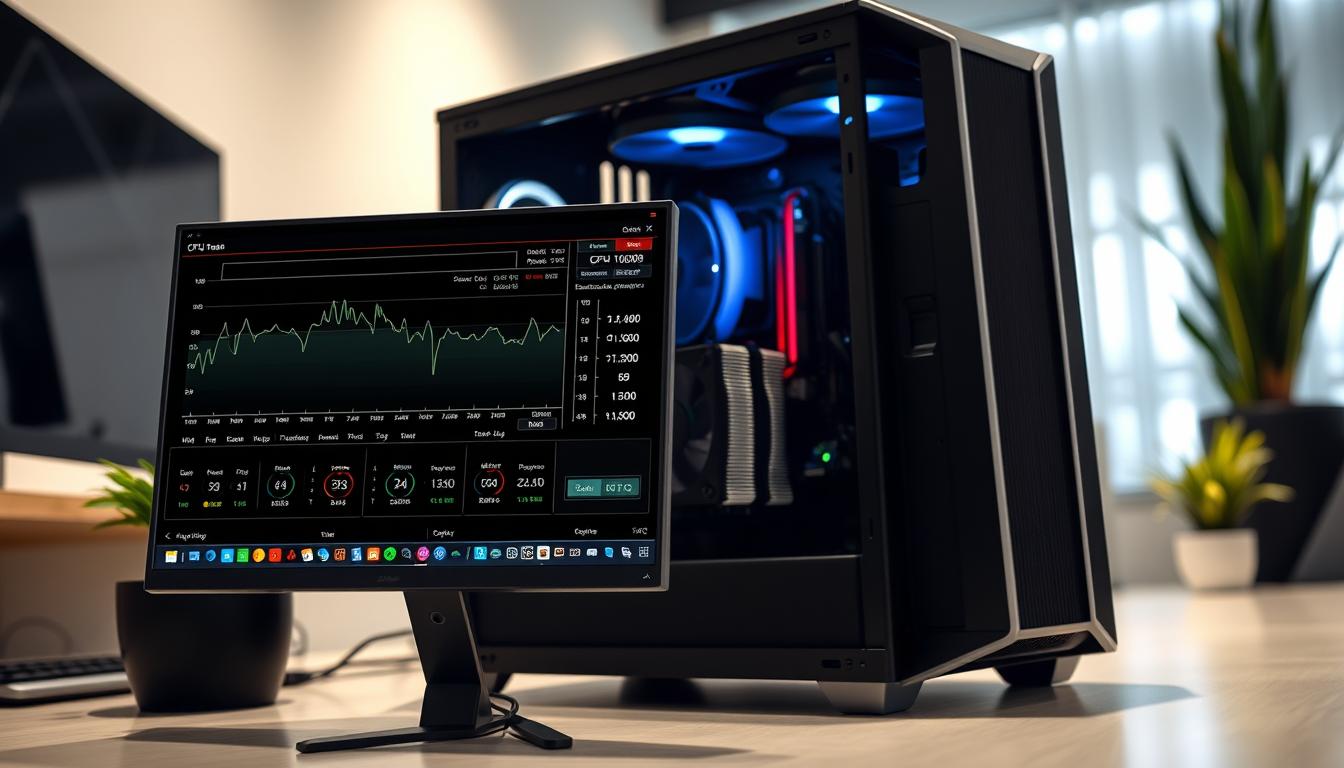Last Updated on August 7, 2025 by Gill
Ever thought your computer might be too hot? High temperatures can lead to reduced performance, damage to components, and even complete system failure. It’s key to know how to check your computer’s temperature to keep it running well. Regularly monitoring the internal temperatures can help you catch potential issues before they escalate. Ignoring overheating can result in gaming PC performance issues that ruin your gaming experience. Consider investing in cooling solutions or cleaning your system to maintain optimal airflow and ensure longevity.
Keeping your computer cool is essential. There are many ways and tools to do this. Whether you use Windows or Mac, there are software and system tools to monitor your computer’s temperature.
In this article, we’ll look at how to check your computer’s temperature. We’ll give you a detailed guide on how to keep your computer running at its best.
Understanding CPU Temperature and Its Importance
Knowing your CPU’s temperature is key to keeping your computer healthy. The CPU’s heat is a sign of its work. It’s vital to manage this heat to avoid damage to your CPU and other parts.
What is CPU Temperature?
CPU temperature shows how hot your CPU is. High heat can harm your CPU’s performance or even crash your system. The CPU, being the heart of your computer, gets hot while working.
Why Monitor CPU Temperature?
Watching your CPU temperature helps spot cooling problems early. This ensures your computer works well and efficiently. Windows and Mac have their ways to check CPU temperature. By monitoring it, you can stop overheating by adjusting cooling or reducing CPU load.
Here’s a look at normal and high CPU temperatures for Windows and Mac:
| System | Normal CPU Temperature | High CPU Temperature |
|---|---|---|
| Windows | 40-70°C | Above 90°C |
| Mac | 50-80°C | Above 100°C |
By keeping an eye on CPU temperature, you keep your computer safe. This boosts its performance and life span.
Key Differences Between Windows and Mac Systems
Windows PCs and Macs handle CPU temperature differently because of their design. Windows PCs offer more hardware choices, letting users customize their systems. This can affect how they monitor CPU temperature. Macs, on the other hand, have a more unified design, making temperature control easier.
Operating System Design
Windows PCs are versatile, fitting many user needs. They let users change their systems a lot, which can change how they watch CPU temperature. Macs, with their all-in-one design, offer a simpler, more controlled setup.
Windows PCs support many software tools for watching CPU temperature. Macs, though, have built-in ways to check temperature or use specific software made for them.
Temperature Management Protocols
Windows PCs and Macs handle temperature in different ways. Windows PCs use third-party software for detailed temperature control. This gives users many choices. Macs, with their built-in design, use special protocols for their hardware.
Looking at both systems shows how they manage temperature differently:
| Feature | Windows PCs | Macs |
|---|---|---|
| Hardware Customization | Highly customizable | Limited customization |
| Temperature Monitoring Software | Variety of third-party options | Integrated and specific Mac-compatible software |
| Temperature Management | Flexible, user-controlled | Automated, optimized for hardware |
Knowing these differences helps pick the right tools for watching CPU temperature. This ensures your system runs well and lasts long.
Best Tools for CPU Temperature Monitoring on Windows
Windows users have many tools to watch their CPU’s temperature. These tools not only show real-time data but also help keep the CPU running well.
Core Temp
Core Temp is a top choice for CPU temperature monitoring. It shows the temperature of each CPU core in real-time. This helps users keep their processor healthy. In addition to providing accurate temperature readings, Core Temp offers valuable features such as temperature logging and notification settings for when temperatures exceed safe limits. For optimal performance and longevity of your CPU, it’s essential to follow realtime cpu temperature monitoring tips, which can help you identify overheating issues before they become problematic. With these insights, users can make informed decisions about cooling solutions and overall system maintenance.
Core Temp also gives detailed info about the CPU. This includes the model name, platform, and frequency. This info is great for understanding how the CPU works and its temperature.
HWMonitor
HWMonitor is a versatile tool that watches CPU temperature, voltages, and fan speeds. It’s a hit with PC fans who want to see how their system is doing.
HWMonitor is easy to use. It’s great for both new and experienced users. They can easily understand the data it shows.
MSI Afterburner
MSI Afterburner is known for overclocking, but it also monitors temperature well. It lets users watch CPU and GPU temperature in real-time. This is useful for those who want to keep an eye on both.
MSI Afterburner also has customizable fan profiles. This makes it perfect for gamers and overclockers who need to control their system’s performance.

| Tool | Primary Function | Additional Features |
|---|---|---|
| Core Temp | CPU Temperature Monitoring | Detailed CPU Information, Real-time Updates |
| HWMonitor | Comprehensive System Monitoring | Monitors Voltages, Fan Speeds, and CPU Temperature |
| MSI Afterburner | Overclocking and Monitoring | GPU and CPU Temperature Monitoring, Customizable Fan Profiles |
These tools help Windows users keep their CPU cool. This improves system performance and makes it last longer. Additionally, maintaining an optimal temperature can prevent thermal throttling, which occurs when a CPU slows down to avoid overheating. For those interested in understanding their system’s limitations, a bottleneck calculator explained can help discern which components may hinder overall performance. By leveraging these tools, users can not only enhance cooling but also ensure a more efficient and balanced system. Moreover, understanding how different components interact can assist users in upgrading their systems strategically. This knowledge can be crucial for fixing PC bottlenecks effectively, allowing for improvements in gaming, multitasking, and overall user experience. By combining proper cooling with thoughtful upgrades, users can create a powerful and efficient computing environment.
Effective CPU Temperature Monitoring on Mac
Mac users have many tools to keep an eye on CPU temperature. These tools help keep systems running well and prevent overheating.
Macs Fan Control
Macs Fan Control lets users watch and adjust fan speeds. This helps manage CPU temperature. Adjusting fan settings keeps the Mac’s temperature safe, ensuring it works its best.
- Monitor and control fan speeds
- Customize fan settings for optimal cooling
- Real-time temperature monitoring
iStat Menus
iStat Menus shows system stats, like CPU temperature, right from the menu bar. It’s great for those who want to watch their system’s performance and temperature closely.
“iStat Menus is a powerful tool that gives you a detailed view of your Mac’s system stats, including CPU temperature, fan speeds, and more.”
Intel Power Gadget
Intel Power Gadget gives insights into CPU frequency and temperature. It’s useful for power users. Monitoring CPU temperature and frequency helps optimize system performance and avoid overheating.

Using these tools, Mac users can keep their CPU temperature in check. This ensures their systems run smoothly and efficiently.
How to Read CPU Temperature Data
Knowing how to read CPU temperature data is key to keeping your computer healthy. It’s important to understand the temperature readings. This ensures your computer stays within safe operating limits.
Celsius vs. Fahrenheit
CPU temperature can be shown in Celsius or Fahrenheit. Most tools use Celsius by default, but some let you switch. Knowing both scales is vital for comparing data from different sources. To ensure optimal performance and prevent overheating, it’s important for users to understand how to monitor CPU temperature effectively. Many software options are available that can provide real-time readings and alerts if temperatures exceed safe limits. By being aware of these metrics and adjusting settings accordingly, users can maintain their system’s longevity and efficiency.
Celsius is the standard for CPU temperature monitoring, part of the metric system. Fahrenheit might be more common in the United States.

Normal Operating Ranges
Safe CPU temperatures vary by model. Generally, 40°C to 80°C is safe for most CPUs during normal use. But, these ranges can change based on the CPU model and how hard it’s working.
| CPU Model | Idle Temperature | Load Temperature |
|---|---|---|
| Intel Core i5 | 30°C – 50°C | 60°C – 80°C |
| AMD Ryzen 7 | 40°C – 60°C | 65°C – 85°C |
Always check your CPU’s specs to find its safe temperature range. You can find this info on the manufacturer’s website or in the CPU’s manual.
Troubleshooting High CPU Temperatures
CPU temperature issues come from many factors. Knowing how to fix them is key. High CPU temperatures can harm your system’s performance, damage parts, and shorten your computer’s life.

Common Causes of Overheating
Several things can make your CPU too hot. Dust buildup on coolers and fans is a big problem. It blocks air and makes cooling less effective. Malfunctioning fans or cooling systems also raise temperatures. So does running your computer in high ambient temperatures.
- Dust accumulation on CPU coolers and fans
- Failing or malfunctioning cooling systems
- High environmental temperatures
- Inadequate airflow around the computer
Experts say dust buildup is a top cause of overheating. Regular cleaning can greatly lower the risk of high CPU temperatures.
“Regular maintenance, such as cleaning dust from vents and fans, is key for keeping CPU temperatures in check.”
Tips to Reduce CPU Temperature
To lower CPU temperatures, there are steps you can take. Cleaning dust from vents and fans is a simple but effective action. Making sure proper airflow is around your computer helps too. You can do this by rearranging your workspace or using a cooling pad for laptops. Also, monitoring CPU temperature often can spot problems early.
- Clean dust from computer vents and fans regularly
- Ensure good airflow around the computer
- Use cooling pads for laptops
- Monitor CPU temperature regularly
By knowing why CPU temperatures get high and using these tips, you can keep your CPU safe. This ensures your computer runs well and lasts longer.
Enhancing Cooling Solutions for Both Systems
Keeping your CPU cool is key to its performance. Both Windows and Mac systems can use better cooling methods. This includes picking the right CPU cooler and making sure there’s good airflow.
Selecting the Right CPU Cooler
Choosing the right CPU cooler depends on your system’s setup and needs. There are mainly two types: air coolers and liquid cooling systems. Air coolers are generally more affordable and easier to install, making them a popular choice for many users. Conversely, liquid cooling systems can offer superior cooling efficiency, especially when performing intensive tasks such as gaming or 3D rendering. For those looking to maximize their system’s potential, especially with high-end GPUs like the RTX 4090, a detailed rtx 4090 performance analysis can help determine the best cooling solution to maintain optimal temperatures and enhance performance.
- Air Coolers: These are the most common. They have a heatsink and a fan. Air coolers are cheaper and simpler to install.
- Liquid Cooling Systems: These use liquid to take heat from the CPU and move it to a radiator. Liquid cooling works best for high-performance systems or overclocked CPUs.
When picking a CPU cooler, think about its fit with your CPU socket, how well it cools, and how loud it is. Software tools can also check if your cooler is working well.
Importance of Proper Ventilation
Good airflow is key to keeping your computer cool. It helps keep the CPU temperature down, improving performance and life.
- Ensure Good Case Airflow: Use case fans to keep air moving through the computer case. This helps get rid of hot air and brings in cooler air.
- Regular Maintenance: Clean dust from your computer’s fans and heatsinks often. Dust can make your cooling system less effective.
- Optimal Placement: Place your computer in a spot with good airflow. This ensures it gets cool air.
Using the right CPU cooler and good ventilation can greatly improve your system’s cooling. Tools to watch temperature and adjust your setup can make it even better.
Conclusion: Choosing the Right Method for Your Needs
Choosing the right CPU temperature monitoring method depends on your specific needs. This is true whether you’re using a Windows PC or a Mac. By understanding the different methods and tools available, you can pick the best one for your system and preferences.
Effective CPU temperature monitoring is key to keeping your computer healthy. It ensures your computer runs well and efficiently. Whether you’re a gamer, a professional, or just a casual user, it’s important to keep an eye on your CPU temperature. There are various tools and software that can help you understand how to monitor CPU temperature effectively. By regularly checking your CPU temperature, you can detect any overheating issues early and take appropriate measures to prevent potential damage. This proactive approach not only prolongs the lifespan of your hardware but also enhances overall system performance.
By choosing the right tool, you can improve your computer’s performance and prevent overheating. This knowledge helps you make informed decisions about CPU temperature monitoring on Windows or Mac.
- RTX 3070 Bottleneck Calculator: Optimize Your Setup - September 27, 2025
- Optimize Your RTX 3060 Ti: Use Our Bottleneck Calculator - September 26, 2025
- GeForce RTX 5060 Bottleneck Calculator – Find Your GPU’s Limits - September 25, 2025











